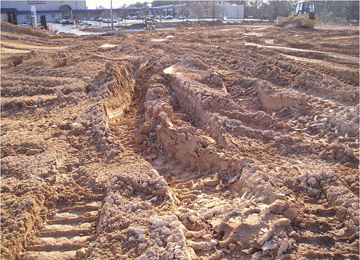Summer is typically the best time to start site soil grading. Unfortunately, not all projects can be completed before winter weather sets in. While site grading can still be done during the winter months, it is more costly and generally takes more time due to wetter soils and harsher weather conditions. Otherwise, good soils are frequently wasted because of frost and higher moisture content.
Winter Soil Grading Techniques
To help successfully manage these conditions, there are techniques that can keep your project moving forward if you must conduct grading activities during the winter season.
Grade the Building Pad High and Crowned
Standard summer practice is to grade a building pad to subgrade elevation, leaving it flat while foundations and walls are constructed. However, during the winter months, this practice can spell disaster. As soils get wet and construction equipment drives across the site, the subgrade can lose strength, requiring an undercut to prepare for slab construction.
Grading the building pad high and crowned helps protect the slab subgrade from direct contact with heavy construction traffic. When the time comes to construct the slab, the additional soils are cut to subgrade elevation, with little or no additional undercut necessary. This technique is especially cost-effective if the building pad is “in cut” (such as on a hillside).
Weatherproof Subgrades
Another technique is to grade to subgrade and place a well-graded stone base, such as crusher run stone. Compacted crusher run tends to shed water, whereas washed stone (an open-graded stone) will actually hold water.
Winter is also an excellent time to stabilize wet soils using cement or lime (quick or hydrated, but not agricultural lime). Lime can help dry any soil and be used to stabilize certain clays chemically. Cement helps dry soil and doubles as a stabilizing agent. Properly employed, both lime and cement can be used to create nearly weatherproof subgrades.
Let the Soil Dry Before Adding the Next Lift
Work larger areas with each lift. Placing soil over a larger area allows more time for the soil to dry before the next lift is added.
Use Lighter Equipment When Working on Wet Soil
Work wet soils with light equipment. Wet soils can be compacted if they are within a compactable moisture range. However, repeatedly crossing wet soils with heavy equipment, such as dump trucks or pans, can cause the soil to start “pumping,” even if it was previously compacted and stable. Wetter soils can be worked by pushing them out into a lift with a self-propelled compactor from a single dump point.
Slope the Site to Clear Water
Finally, there is simply no substitute for good housekeeping. The site should be sloped to clear water quickly and channel it away from the work area. It’s also good practice to establish a network of roads to direct construction traffic away from unstable areas on the site. Construction roads can be stabilized using crusher run or geotextiles so that access can continue even during the worst weather conditions. It is also important to properly maintain construction roadways during the winter. Potholes, rough areas, and wheel ruts must regularly be filled in to facilitate rain or snow melt clearing. Equally important, contractors must enforce access discipline.
Winter construction can increase project costs, especially site grading. The additional costs and extra time should be figured into project schedules and budgets. However, careful planning and proper execution can reduce these costs and help make your project successful.

